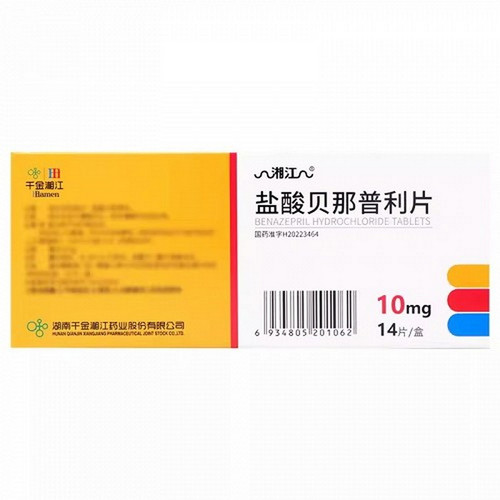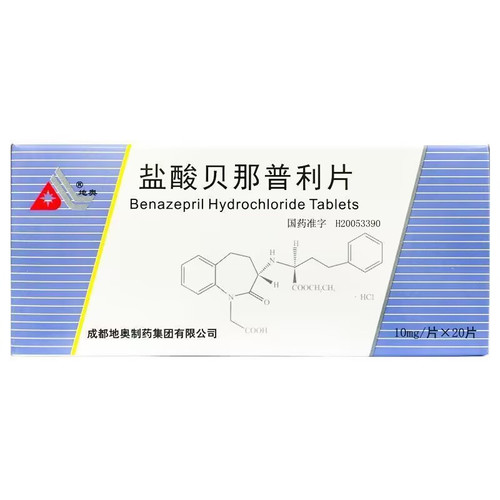Product Overview
[Drug Name]
Generic Name: Benazepril Hydrochloride Tablets
Trade Name: Xinyafushu
English Name: Benazepril Hydrochloride Tablets
Chinese Pinyin: Yansuan Beinapuli Pian
[Ingredients]
3-[(1-ethoxycarbonyl-3-phenyl-(1S)-propyl)amino]-2,3,4,5-tetrahydro-2-oxo-1H-1-(3S)benzazepine-1-acetic acid hydrochloride.
[Properties]
This product is a film-coated tablet that appears white after removal of the film coating.
[Indications]
Hypertension (can be used alone or in combination with other antihypertensive drugs, such as diuretics) and heart failure (can be used alone or in combination with cardiotonic diuretics).
[Usage and Dosage]
1. Adult dosage (1) Antihypertensive: For those who are not taking diuretics, the recommended initial dose is 10 mg orally once a day; for those who are already taking diuretics (except for severe and malignant hypertension), diuretics should be discontinued for 2 to 3 days before using this product. The dosage should be increased in small doses and carefully under observation. If blood pressure cannot be satisfactorily controlled with once-daily administration, the dose can be increased or divided into two doses, and the maintenance dose can reach 20 mg to 40 mg/day. For those with poor renal function or water or sodium deficiency, the initial dose is 5 mg once a day. (2) Heart failure: The recommended initial dose is 5 mg orally once a day. Blood pressure should be monitored during the first dose. The maintenance dose can be 5 mg to 10 mg once a day. Severe heart failure requires a smaller dose than mild to moderate heart failure. 2. There is no research data on the dosage for children. [Adverse Reactions] 1. Common side effects include: headache, dizziness, fatigue, drowsiness, nausea, and cough. The most common are headache and cough. 2. Rare symptoms include: symptomatic hypotension, postural hypotension, syncope, palpitations, peripheral edema, rash, dermatitis, constipation, gastritis, anxiety, insomnia, paresthesia, arthralgia, myalgia, and asthma. Angioneurotic edema is rare.
[Contraindications]
Allergy to benazepril or other angiotensin-converting enzyme inhibitors. Patients with a history of angioneurotic edema. Patients with solitary kidney, transplanted kidney, or bilateral renal artery stenosis and renal impairment.
[Precautions]
1. Angioneurotic edema: If lip or facial edema has occurred while taking this product, discontinue the drug immediately and monitor the patient until the edema resolves. Edema of the glottis, tongue, or larynx may cause airway obstruction and should be discontinued. Immediately initiate appropriate treatment, such as subcutaneous injection of 1:1000 epinephrine solution (0.3ml-0.5ml). 2. Hypotension: Patients with severe sodium deficiency and volume depletion may experience hypotension when taking this drug (such as those receiving large amounts of diuretics or dialysis). Diuretics should be discontinued or other measures should be taken to replenish body fluids several days before starting this drug. Patients at risk of severe hypotension (such as those with heart failure) should be closely monitored after the first dose until their blood pressure stabilizes. If hypotension occurs, the patient should be placed in the supine position and receive intravenous saline if necessary. 3. Granulocytopenia: Patients with autoimmune diseases and renal insufficiency are more likely to experience leukopenia or granulocytopenia. For patients with renal insufficiency or leukopenia, check the white blood cell count and differential every two weeks for the first three months and regularly thereafter. 4. Renal Insufficiency: A small number of patients may experience transient increases in blood urea nitrogen and creatinine after taking this drug, which resolves with discontinuation of this drug and/or diuretics. For patients with renal insufficiency, renal function should be closely monitored during the first few weeks of treatment and regularly thereafter. When using this drug, if the creatinine clearance is less than 30 ml/min or blood urea nitrogen or creatinine levels are elevated, the dose should be reduced and/or diuretics should be discontinued. Other: Elevated serum potassium may occur occasionally, especially in patients with renal insufficiency and when taking medications to treat hypokalemia. Elevated aminotransferases may occur occasionally. Insufficient blood supply to the brain or coronary arteries may be exacerbated by decreased blood pressure. Hepatic metabolism of this drug is decreased in patients with hepatic dysfunction.
[Special Use in Special Populations]
Precautions for Use in Children:
No safety and efficacy studies are available for this drug in children.
Precautions for Use During Pregnancy and Lactation:
This drug should not be used by pregnant women (see [Contraindications]). 1. Pregnancy: The use of ACE inhibitors by pregnant women may cause fetal or neonatal morbidity or death. Dozens of such cases have been reported in the literature worldwide. Use of ACE inhibitors during the second and third trimesters may cause fetal and neonatal harm, including hypotension, neonatal skull deformity, anuria, reversible or irreversible renal impairment, and even death. The resulting polyhydramnios often leads to limb contractures, facial deformities, and lung hypoplasia in the infant. Premature birth, intrauterine growth retardation, and patent ductus arteriosus have also been reported, but it is unclear whether these symptoms are related to ACE inhibitor use. Use of ACE inhibitors during early pregnancy is associated with an increased risk of birth defects. Once pregnancy is confirmed, ACE inhibitor use should be discontinued immediately, and fetal growth should be monitored regularly. ACE inhibitors (including Lotensin) should also be avoided in women planning pregnancy. Women of childbearing age should be specifically informed of the potential risks of taking ACE inhibitors (including Lotensin). They should only be administered after careful consideration and discussion of the associated risks and benefits. 2. Breastfeeding Women: Benazepril and benazeprilat have been found to be excreted in breast milk, but the maximum concentration is only 0.3% of the plasma level. Negligible amounts of benazeprilat reach the infant's systemic circulation. While adverse effects on breastfed infants are unlikely, use of this medication during breastfeeding is not recommended.
Precautions for Elderly Patients:
This medication should be used in the same manner as adults in elderly patients.
[Drug Interactions]
1. Concomitant use with diuretics may enhance the antihypertensive effect and may cause severe hypotension. Therefore, the existing diuretic should be discontinued or reduced, and this product should be started with a low dose and gradually adjusted. 2. Concomitant use with other vasodilators may cause hypotension. If used together, the dose should be started at a low level. 3. Concomitant use with potassium-sparing diuretics (such as spironolactone, triamterene, and amiloride) may cause hyperkalemia. 4. Concomitant use with nonsteroidal anti-inflammatory analgesics may weaken the antihypertensive effect of this product by inhibiting prostaglandin synthesis and sodium and water retention. 5. Concomitant use with other antihypertensive drugs may enhance the antihypertensive effect. This effect is significantly additive with drugs that induce renin release or affect sympathetic activity, while it is less than additive with beta-blockers.
[Pharmacological Action]
Pharmacology (1) Antihypertensive: This product is hydrolyzed into benazeprilat in the liver, becoming a competitive angiotensin-converting enzyme inhibitor, preventing the conversion of angiotensin I to angiotensin II, reducing vascular resistance, reducing aldosterone secretion, and increasing plasma renin activity. Benazeprilat also inhibits the degradation of bradykinin, which also reduces vascular resistance and produces a antihypertensive effect. (2) Reduce cardiac load: This product dilates arteries and veins, reduces peripheral vascular resistance or cardiac afterload, reduces pulmonary capillary entrapment pressure or cardiac preload, and also reduces pulmonary vascular resistance, thereby improving cardiac output and prolonging exercise tolerance and time. Toxicology: Rats and mice were given benazepril orally for 2 years at a dose of 150 mg/kg per day, and no carcinogenicity was found. (This dose, calculated as mg/kg, is 110 times the maximum human dose; calculated as mg/m2, is 18 times and 9 times the maximum human dose). This product was not found to be mutagenic in either bacterial or in vitro mammalian cell culture assays. Oral administration of benazepril to male and female rats at doses of 50 to 150 mg/kg per day did not affect reproductive performance. (This dose, calculated on a mg/kg basis, is 37 to 375 times the maximum human dose; calculated on a mg/m² basis, is 6 to 60 times the maximum human dose.)
Storage: Store in a cool, dry place.
Strength: 10 mg
Packaging: 10 mg x 14 tablets
Shelf Life: 24 months
Approval Number: National Medicine Standard H20044840
Manufacturer: Shanghai Xinya Pharmaceutical Minhang Co., Ltd.







